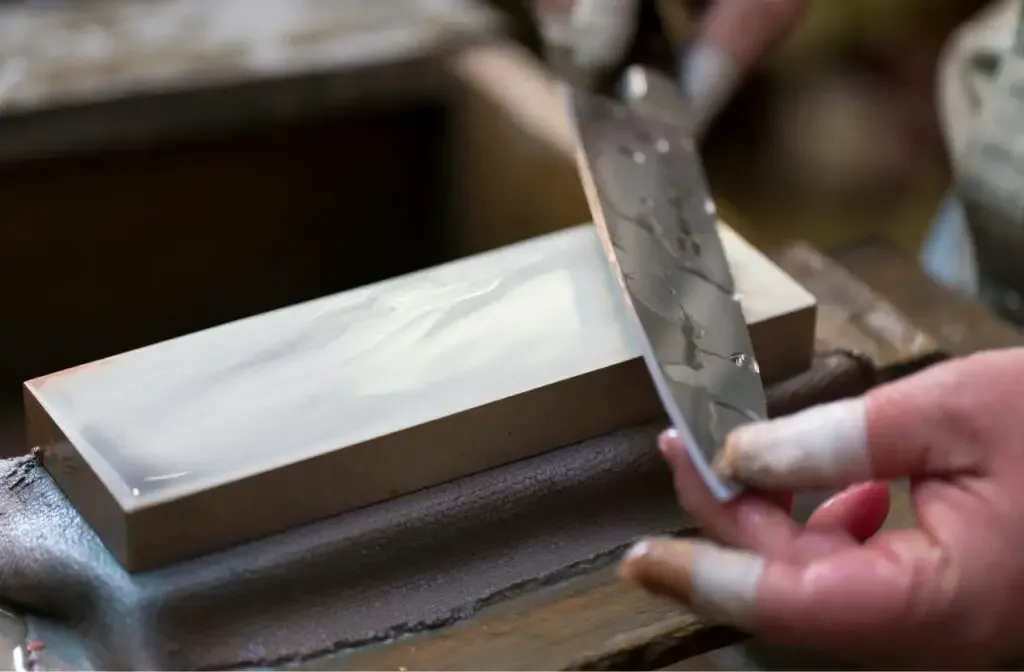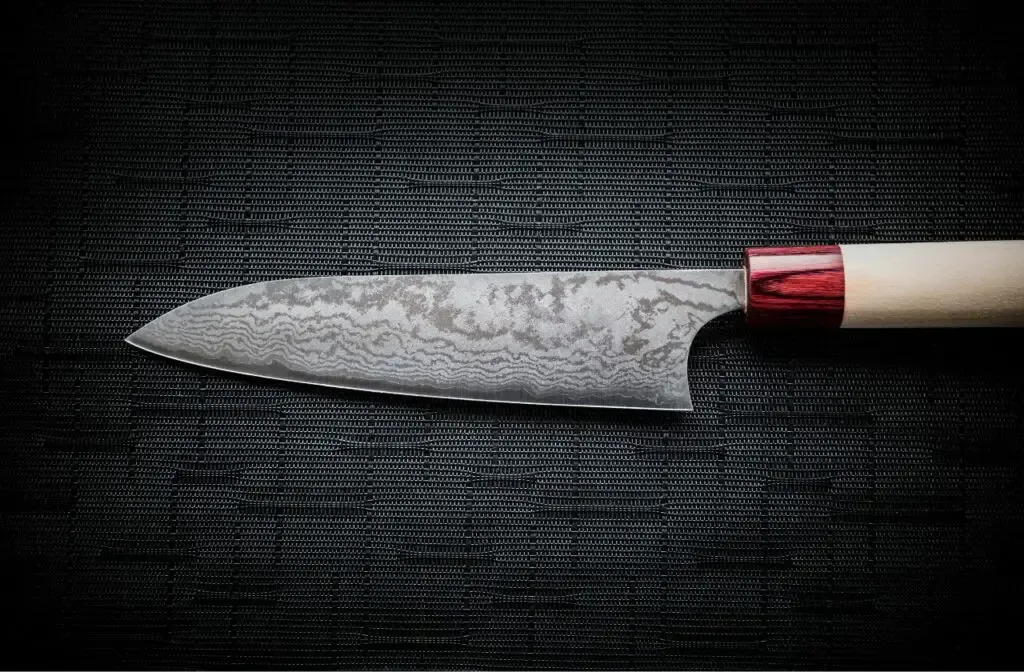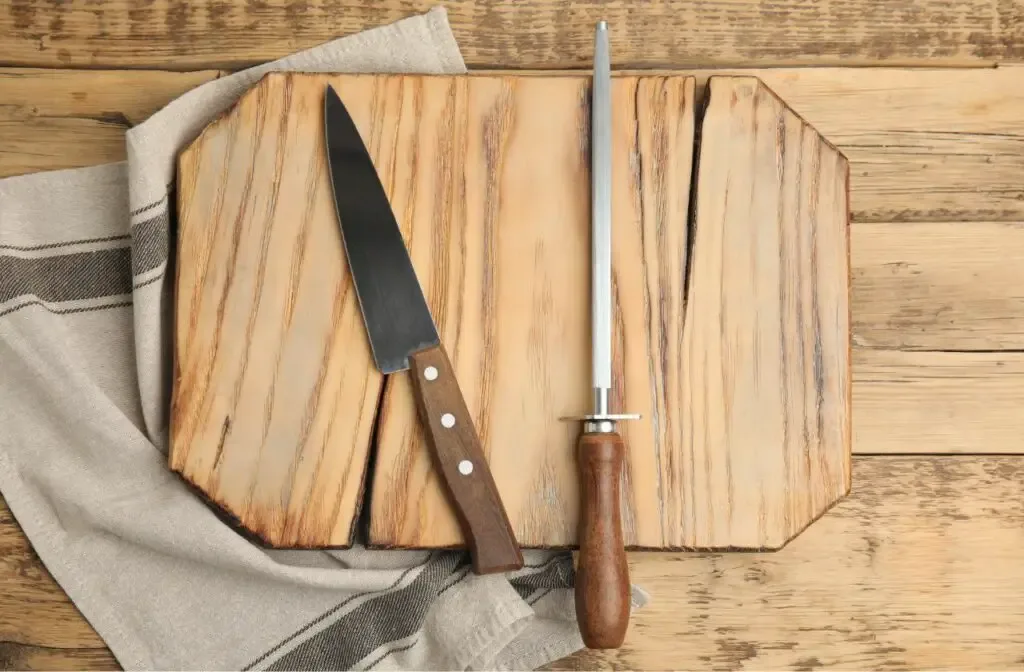As an Amazon Associate, we earn from qualifying purchases with no additional costs for you.
A question that has perplexed many newcomers to knife sharpening is the frustration of a knife not getting sharp. The disappointment of dragging a knife through a tomato only to squash it or attempting to achieve a fine chop and being met with uneven slices due to a dull knife is an annoyance. What is going wrong to cause your knife not to be sharp after sharpening?
Your knife may not get sharp due to incorrect technique, wrong grit selection, or the wrong sharpening tool. The steel used in the knife blade will also affect the ease of sharpening the knife. Practice is key to honing skills, and selecting the right equipment goes a long way to improve results.
A knife note getting sharp after sharpening could be the result of many factors or a combination of factors, some of which you can rectify by improving your skill level or technique, but other factors may be due to the knife itself. We will explore these possibilities so you can decide which factor is causing your knife to not get sharp.
Using the right tools to keep your knives sharp is important. Good-quality whetstones are among the best options. Check out some options for good knife sharpening stone set by Atoma here (Amazon Link)
What Causes A Knife To Not Get Sharp?

Taking a knife from a dull edge to a razor-sharp blade can sometimes be riddled with unexpected roadblocks. Whether it’s the bewildering array of sharpening stones, the mystery of finding the perfect sharpening angle, or the enigma of achieving that flawless edge, the path to sharpness can sometimes veer off into a world of bluntness and bafflement.
The issues that may result in your knife not getting sharp may be your sharpening technique, incorrect grit selection, the sharpening tool being used, or the knife blade material.
We will discuss each of these options so you can establish which issue is most likely the cause in your circumstance.
Understanding Knife Sharpening: Basic Concepts
Knife sharpening is not merely about grinding a blade against a stone but involves a meticulous process that, when done correctly, results in a finely honed edge.
Key Terminologies in Knife Sharpening
- Sharpening Angle: The angle at which the knife is held against the sharpening stone. It is pivotal in determining the sharpness and durability of the edge.
- Burr: A tiny, often perceptible ridge of metal that forms on the opposite side of the edge being sharpened. It indicates that the sharpening process has reached the blade’s edge.
- Grit: The coarseness of the sharpening stone, which influences the material removal rate and the fineness of the sharpened edge.
- Honing: The process of realigning the edge of the blade without removing significant material, often performed with a honing rod.
Understanding these terms will facilitate a smoother navigation through the sharpening process and enable a greater comprehension of the techniques and tips we will discuss.
The Sharpening Process: An Overview

- Selecting the Appropriate Grit:
- Coarse grit (up to 1000): For repairing chips and setting a new edge.
- Medium grit (1000-3000): For sharpening and maintaining a working edge.
- Fine grit (4000 and above): For polishing and refining the edge.
- Determining the Sharpening Angle:
- Lower angles (10-17 degrees): For sharper but less durable edges, often used for slicing knives.
- Higher angles (18-25 degrees): For durable edges suitable for chopping and heavier tasks.
- Forming the Burr:
- Sharpening one side of the blade until a burr forms along the entire edge.
- Ensuring the burr is consistent and detectable by gently feeling against the edge.
- Burr Removal and Polishing:
- Switching to finer grit stones and alternating sides to progressively remove the burr and polish the edge.
- Honing the knife to refine and maintain the edge between sharpening sessions.
| Usage | Grit Type | Best Option |
|---|---|---|
| Fixing stone | 320 grit | Shapton Kuromaku 320 |
| Establishing the Edge | 400 grit | Naniwa Chosera 400 |
| Sharpening Stone | 600 grit | Naniwa Chosera 600 |
| Sharpening Stone | 800 grit | Naniwa Chosera 800 |
| Finishing Stone | 1000 grit | Suehiro CERAX |
| Polishing Stone | 2000 grit | Shapton Kuromaku 2000 |
| Polishing Stone | 5000 grit | Shapton Kuromaku 5000 |
| Extra Polishing Stone | 8000 grit | Shapton Kuromaku 8000 |
| Mirror Polishing Stone | 12000 grit | Shapton Kuromaku 12000 |
The Interplay Of Angle, Grit, And Technique
The synergy between the sharpening angle, the chosen grit, and the applied technique determines the success of the sharpening process.
A keen awareness of how these elements interact enables you to understand various knives and their respective requirements, ensuring each blade is sharpened to its optimal potential.
The Significance of Consistent Practice
Sharpening is as much a skill as it is a science. Consistent practice and a foundational understanding of its principles will pave the way towards mastering the art of knife sharpening, ensuring your blades are always in peak condition.
Common Challenges In Knife Sharpening
While seemingly straightforward, knife sharpening can present many challenges even to those well-acquainted with the process.
From maintaining a steady, consistent angle to ensuring the formation of a consistent burr, sharpeners often find themselves navigating through common pitfalls. Let’s explore these challenges and set the stage for uncovering solutions in the subsequent sections.
TIP: The process of sharpening a knife does not have to be difficult. Find out the best way to sharpen your knives in the article below:
Step-By-Step GUIDE: How To Sharpen A Knife With A Whetstone
Sharpening At The Incorrect Angle
The angle at which a knife edge is sharpened significantly influences its performance and durability. An incorrect angle can result in an edge that is either too fragile or insufficiently sharp.
| Angle | Resulting Edge | Suitable For | Challenges |
| Low | Extremely sharp, fragile | Slicing, delicate tasks | Prone to chipping, requires frequent sharpening |
| High | Durable, less sharp | Chopping, heavy-duty tasks | May lack precision in slicing |
Inconsistent Sharpening Angle
Maintaining a consistent, steady angle throughout the sharpening process is pivotal for achieving a uniformly sharp edge. Inconsistency can lead to an uneven edge, reducing the knife’s sharpness and potentially making it unsafe.
Understanding the sharpening angle is key to achieving a blade that is both sharp and durable. The angle should be chosen based on the knife’s purpose and the user’s proficiency.
- Lower Angles (10-17 degrees)
- Pros: Yields a razor-sharp edge suitable for precise slicing.
- Cons: The edge is fragile and may chip easily, especially when used on hard materials.
- Higher Angles (18-25 degrees)
- Pros: Produces a robust, durable edge, ideal for chopping and heavy-duty tasks.
- Cons: The edge may lack the sharpness desired for delicate slicing tasks.
Not Sharpening All The Way To The Edge
Achieving a sharp edge necessitates sharpening until the bevels of the knife meet, forming a burr. Incomplete sharpening results in an edge that is not truly sharp, diminishing the knife’s cutting capabilities.
Using The Wrong Sharpening Materials
The selection of sharpening materials, particularly the grit of the sharpening stone, plays a crucial role in the sharpening process. Utilizing an inappropriate grit can either prolong the sharpening process or fail to achieve the desired edge refinement.
| Grit Type | Purpose | Ideal For | Challenges |
| Coarse | Rapid material removal | Setting a new edge, repairing chips | Can induce scratches if not followed by finer grits |
| Medium | General sharpening | Maintaining a working edge | May not repair significantly damaged edges |
| Fine | Polishing and refining | Achieving a razor-sharp, polished edge | Ineffective for initial stages of sharpening |
Quality Of The Knife Material

The quality and type of steel from which a knife is crafted significantly influence its sharpening behavior and edge retention.
- High-Carbon Steel
- Pros: Tends to hold a sharp edge well and is generally easier to sharpen.
- Cons: More prone to rust and requires diligent care.
- Stainless Steel
- Pros: Resistant to rust and staining, offering durability.
- Cons: Can be challenging to sharpen to a razor edge and may lose sharpness relatively quickly.
TIP: There are multiple types of knife steel used for different purposes. Understanding these types of steel is important for getting the most from your knives. Learn more about the type of knife steels in the article below:
Full List: Best Knife Steels For Different Knives (+ Why)
Lack Of Knowledge And Experience
Inadequate understanding of sharpening principles and insufficient practice can lead to ineffective sharpening, potentially causing frustration and discouragement.
In-Depth Analysis Of Sharpening Challenges
Navigating through the sharpening process is often met with challenges that, while common, can be perplexing to both novice and seasoned sharpeners alike. By delving deeper into these challenges, we can uncover the underlying mechanics and pave the way toward effective solutions.
Practical Solutions And Tips
Navigating through the challenges of knife sharpening can be smoother with the right insights and practical solutions at hand. Let’s explore actionable tips and solutions that address the common challenges in knife sharpening, ensuring your blades are always honed to perfection.
Step-by-Step Guide to Effective Sharpening
The following steps will help you take measures to improve your sharpening skills and observe what is happening to the edge during the process.
- Choosing the Right Angle
- Utilize angle guides or sharpening jigs to maintain the desired sharpening angle consistently.
- Refer to the manufacturer’s guidelines or use a general guide based on the knife’s purpose.
- Forming and Identifying the Burr
- Use your fingers to gently feel for the burr along the edge.
- Ensure the burr is formed along the entire length of the blade before moving to the other side.
- Progressing Through Grits
- Start with a coarser grit for setting the edge and move progressively towards finer grits for polishing.
- Ensure each stage effectively refines the scratches from the previous grit.
- Finishing and Honing
- Utilize the finest grit stone or a strop to polish the cutting edge and remove any remaining burr.
- Regularly hone the knife with a honing rod to maintain the edge between sharpening sessions.
Choosing the Right Sharpening Tools and Materials
The right sharpening tool is as important as using the correct technique.
- Sharpening Stones: Select sharpening stones (Amazon link) with appropriate grits to facilitate effective sharpening and polishing.
- Honing Rod: Choose a honing rod (Amazon link) suitable for the steel of your knife and use it regularly to maintain the edge.
- Angle Guides: Utilize angle guides (Amazon link) or jigs to maintain a consistent sharpening angle, especially as a beginner.
- Sharpening Systems: Some sharpening systems (Amazon link) simplify the process and assist in maintaining the correct sharpening angle, making the process easier.
Troubleshooting Common Issues
Coming up against issues is common, especially if you are new to the sharpening process.
- Inconsistent Edge: Revisit the sharpening angle and ensure consistency using guides or jigs.
- Remaining Dullness: Ensure the formation of a burr along the entire edge and refine with appropriate grits.
- Chipping: Opt for a slightly higher sharpening angle for added durability and ensure the knife is used appropriately.
Maintaining the Sharpness: Post-Sharpening Care

Proper knife care after sharpening plays an important role in maintaining sharpness after sharpening.
- Proper Storage: Utilize knife blocks, magnetic strips, or blade guards to protect the edge.
- Mindful Usage: Use the knife on suitable cutting surfaces (e.g., wooden or soft plastic boards) and avoid using it on hard materials.
- Regular Honing: Employ a honing rod to realign the edge regularly, prolonging the intervals between sharpening sessions.
Conclusion
Mastering the art and science of sharpening requires practice, patience, and a keen understanding of the subtle nuances that transform a dull blade into a precision cutting tool.
There is a lot to learn from understanding the pivotal role of sharpening angles and recognizing the significance of burr formation, using the right tools, and evaluating the knife steel.
Persevering with improving your sharpening skills is well worth the time and effort, so persist with honing your knife sharpening skills, and you will get to the point where your knives remain sharp!
TIP: Knife care is important for every knife, regardless of what type of knife it is. You can learn more about how to take proper care of your knives in the article below:
Knife Care: When & How To Clean & Sanitize Your Knives
